Omar Khayyam
| Omar Khayyam عمر خیام | |
|---|---|
|
| |
| Born |
18 May[1] 1048[2] Nishapur, Khorasan (present-day Iran) |
| Died |
4 December[1] 1131 (aged 83)[2] Nishapur, Khorasan (present-day Iran) |
| Nationality | Persian |
| School | Islamic mathematics, Persian poetry, Persian philosophy |
Main interests | Mathematics, Astronomy, Avicennism, Poetry |
|
Influences
| |
|
Influenced
| |
Omar Khayyam (/kaɪˈjɑːm/; Persian: عمر خیّام [ˈoːmɒːɾ xæjˈjɒːm]; 18 May 1048 – 4 December 1131) was a Persian mathematician, astronomer, and poet.[3][4] He was born in Nishapur, in northeastern Iran, and spent most of his life near the court of the Karakhanid and Seljuq rulers in the period which witnessed the First Crusade.
As a mathematician, he is most notable for his work on the classification and solution of cubic equations, where he provided geometric solutions by the intersection of conics.[5] Khayyam also contributed to the understanding of the parallel axiom.[6]:284 As an astronomer, he designed the Jalali calendar, a solar calendar with a very precise 33-year intercalation cycle.[7][8]:659
There is a tradition of attributing poetry to Omar Khayyam, written in the form of quatrains (rubāʿiyāt رباعیات). This poetry became widely known to the English-reading world in a translation by Edward FitzGerald (Rubaiyat of Omar Khayyam, 1859), which enjoyed great success in the Orientalism of the fin de siècle.
Life
Omar Khayyam was born in Nishapur, a leading metropolis in Khorasan during medieval times that reached its climax of prosperity in the eleventh century under the Seljuq dynasty.[9]:15[10][11] Nishapur was then religiously a major center of Zoroastrians. It is likely that Khayyam's father was a Zoroastrian who had converted to Islam.[12]:68 He was born into a family of tent-makers (Khayyam). His full name, as it appears in the Arabic sources, was Abu’l Fath Omar ibn Ibrāhīm al-Khayyām.[13] In medieval Persian texts he is usually simply called Omar Khayyām.[14] The historian Bayhaqi, who was personally acquainted with Omar, provides the full details of his horoscope: "he was Gemini, the sun and Mercury being in the ascendant[...]".[15]:471 This was used by modern scholars to establish his date of birth as 18 May 1048.[8]:658
His boyhood was passed in Nishapur.[8]:659 His gifts were recognized by his early tutors who sent him to study under Imam Muwaffaq Nīshābūrī, the greatest teacher of the Khorasan region who tutored the children of the highest nobility.[12]:20 In 1073, at the age of twenty-six, he entered the service of Sultan Malik-Shah I as an adviser. In 1076 Khayyam was invited to Isfahan by the vizier and political figure Nizam al-Mulk to take advantage of the libraries and centers in learning there. His years in Isfahan were productive. It was at this time that he began to study the work of Greek mathematicians Euclid and Apollonius much more closely. But after the death of Malik-Shah and his vizier (presumably by the Assassins' sect), Omar had fallen from favour at court, and as a result, he soon set out on his pilgrimage to Mecca. A possible ulterior motive for his pilgrimage reported by Al-Qifti, is that he was attacked by the clergy for his apparent skepticism. So he decided to perform his pilgrimage as a way of demonstrating his faith and freeing himself from all suspicion of unorthodoxy.[12]:29 He was then invited by the new Sultan Sanjar to Marv, possibly to work as a court astrologer.[1] He was later allowed to return to Nishapur owing to his declining health. Upon his return, he seemed to have lived the life of a recluse.[16]:99 Khayyam died in 1131, and is buried in the Khayyam Garden.
Mathematics
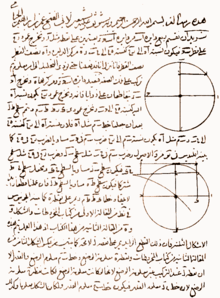
Khayyam was famous during his life as a mathematician. His surviving mathematical works include: A commentary on the difficulties concerning the postulates of Euclid's Elements (Risāla fī šarḥ mā aškala min muṣādarāt kitāb Uqlīdis, completed in December 1077[4]), On the division of a quadrant of a circle (Risālah fī qismah rub‘ al-dā’irah, undated but completed prior to the treatise on algebra[4]), and On proofs for problems concerning Algebra (Maqāla fi l-jabr wa l-muqābala, most likely completed in 1079[6]:281). He furthermore wrote a treatise on extracting the nth root of natural numbers, which has been lost.[12]:197
Theory of parallels
A part of Khayyam's commentary on Euclid's Elements deals with the parallel axiom.[6]:282 The treatise of Khayyam can be considered the first treatment of the axiom not based on petitio principii, but on a more intuitive postulate. Khayyam refutes the previous attempts by other mathematicians to prove the proposition, mainly on grounds that each of them had postulated something that was by no means easier to admit than the Fifth Postulate itself.[4] Drawing upon Aristotle's views, he rejects the usage of movement in geometry and therefore dismisses the different attempt by Al-Haytham.[17][18] Unsatisfied with the failure of mathematicians to prove Euclid's statement from his other postulates, Omar tried to connect the axiom with the Fourth Postulate, which states that all right angles are equal to one another.[6]:282
Khayyam was the first to consider the three cases of acute, obtuse, and right angle for the summit angles of a Khayyam-Saccheri quadrilateral, three cases which are exhaustive and pairwise mutually exclusive.[6]:283 After proving a number of theorems about them, he proved that the Postulate V is a consequence of the right angle hypothesis, and refuted the obtuse and acute cases as self-contradictory.[4] Khayyam's elaborate attempt to prove the parallel postulate was significant for the further development of geometry, as it clearly shows the possibility of non-Euclidean geometries. The hypothesis of the acute, obtuse, and that of the right angle are now known to lead respectively to the non-Euclidean hyperbolic geometry of Gauss-Bolyai-Lobachevsky, to that of Riemannian geometry, and to Euclidean geometry.[19]
Tusi's commentaries on Khayyam's treatment of parallels made its way to Europe. John Wallis, the professor of geometry at Oxford, translated Tusi's commentary into Latin. Jesuit geometrician Girolamo Saccheri, whose work (euclides ab omni naevo vindicatus, 1733) is generally considered as the first step in the eventual development of non-Euclidean geometry, was familiar with the work of Wallis. The American historian of mathematics, David Eugene Smith mentions that Saccheri "used the same lemma as the one of Tusi, even lettering the figure in precisely the same way and using the lemma for the same purpose". He further says that "Tusi distinctly states that it is due to Omar Khayyam, and from the text, it seems clear that the latter was his inspirer."[16]:104[20][12]:195
The real number concept
This treatise on Euclid contains another contribution dealing with the theory of proportions and with the compounding of ratios. Khayyam discusses the relationship between the concept of ratio and the concept of number and explicitly raises various theoretical difficulties. In particular, he contributes to the theoretical study of the concept of irrational number.[4] Displeased with Euclid's definition of equal ratios, he redefined the concept of a number by the use of a continuous fraction as the means of expressing a ratio. Rosenfeld and Youschkevitch (1973) argue that "by placing irrational quantities and numbers on the same operational scale, [Khayyam] began a true revolution in the doctrine of number." Likewise, it was noted by D. J. Struik that Omar was "on the road to that extension of the number concept which leads to the notion of the real number."[6]:284
Geometric algebra
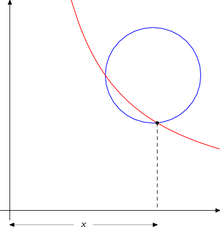
Rashed and Vahabzadeh (2000) have argued that because of his thoroughgoing geometrical approach to algebraic equations, Khayyam can be considered the precursor of Descartes in the invention of analytic geometry.[21]:248 In The Treatise on the Division of a Quadrant of a Circle Khayyam applied algebra to geometry. In this work, he devoted himself mainly to investigating whether it is possible to divide a circular quadrant into two parts such that the line segments projected from the dividing point to the perpendicular diameters of the circle form a specific ratio. His solution, in turn, employed several curve constructions that led to equations containing cubic and quadratic terms.[21]:248
The solution of cubic equations
Khayyam seems to have been the first to conceive a general theory of cubic equations[22] and the first to geometrically solve every type of cubic equation, so far as positive roots are concerned.[23] The treatise on algebra contains his work on cubic equations.[24] It is divided into three parts: (i) equations which can be solved with compass and straight edge, (ii) equations which can be solved by means of conic sections, and (iii) equations which involve the inverse of the unknown.[25]
Khayyam produced an exhaustive list of all possible equations involving lines, squares, and cubes.[26]:43 He considered three binomial equations, nine trinomial equations, and seven tetranomial equations.[6]:281 For the first and second degree polynomials, he provided numerical solutions by geometric construction. He concluded that there are fourteen different types of cubics that cannot be reduced to an equation of a lesser degree.[4] For these he could not accomplish the construction of his unknown segment with compass and straight edge. He proceeded to present geometric solutions to all types of cubic equations using the properties of conic sections.[27]:157[6]:281 The prerequisite lemmas for Khayyam’s geometrical proof include Euclid VI, Prop 13, and Apollonius II, Prop 12.[27]:155 The positive root of a cubic equation was determined as the abscissa of a point of intersection of two conics, for instance, the intersection of two parabolas, or the intersection of a parabola and a circle, etc.[28]:141 However, he acknowledged that the arithmetic problem of these cubics was still unsolved, adding that "possibly someone else will come to know it after us".[27]:158 This task remained open until the sixteenth century, where algebraic solution of the cubic equation was found in its generality by Cardano, Del Ferro, and Tartaglia in Renaissance Italy.[6]:282[4]
Omar Khayyam[29]
In effect, Khayyam's work is an effort to unify algebra and geometry.[30]:241 This particular geometric solution of cubic equations has been further investigated by M. Hachtroudi and extended to solving fourth-degree equations.[31] Although similar methods had appeared sporadically since Menaechmus, Khayyam's work can be considered the first systematic study and the first exact method of solving cubic equations.[32] The mathematician Woepcke (1851) who offered translations of Khayyam's algebra into French praised him for his "power of generalization and his rigorously systematic procedure."[33]:10
Binomial theorem and extraction of roots
Omar Khayyam Treatise on Demonstration of Problems of Algebra[34]
In his algebraic treatise, Khayyam alludes to a book he had written on the extraction of the th root of the numbers using a law which he had discovered which did not depend on geometric figures.[28] This book was most likely titled The difficulties of arithmetic (Moškelāt al-hesāb),[4] and is not extant. Based on the context, some historians of mathematics such as D. J. Struik, believe that Omar must have known the formula for the expansion of the binomial , where n is a positive integer.[6]:282 The case of power 2 is explicitly stated in Euclid's elements and the case of at most power 3 had been established by Indian mathematicians. Khayyam was the mathematician who noticed the importance of a general binomial theorem. The argument supporting the claim that Khayyam had a general binomial theorem is based on his ability to extract roots.[35] The arrangement of numbers known as Pascal's triangle enables one to write down the coefficients in a binomial expansion. This triangular array sometimes is known as Omar Khayyam's triangle.[28]
Astronomy
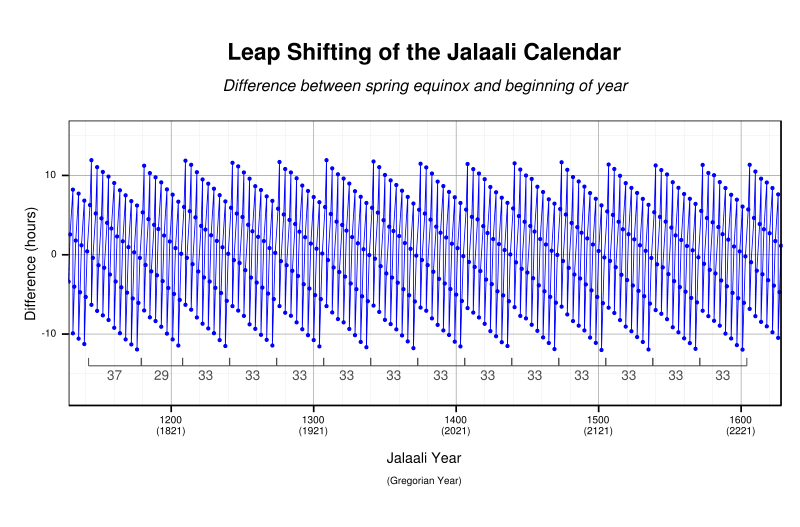
In 1074, Omar Khayyam was commissioned by Sultan Malik-Shah to build an observatory at Isfahan and reform the Persian calendar. There was a panel of eight scholars working under the direction of Khayyam to make large-scale astronomical observations and revise the astronomical tables.[28]:141 Recalibrating the calendar fixed the first day of the year at the exact moment of the passing of the Sun's center across vernal equinox. This marks the beginning of spring or Nowrūz, a day in which the Sun enters the first degree of Aries before noon.[36][37] The resulted calendar was named in Malik-Shah's honor as the Jalālī calendar, and was inaugurated on Friday, March 15, 1079.[38] The observatory itself was disused after the death of Malik-Shah in 1092.[8]:659
The Jalālī calendar was a true solar calendar where the duration of each month is equal to the time of the passage of the Sun across the corresponding sign of the Zodiac. The calendar reform introduced a unique 33-year intercalation cycle. As indicated by the works of Khazini, Khayyam's group implemented an intercalation system based on quadrennial and quinquennial leap years. Therefore, the calendar consisted of 25 ordinary years that included 365 days, and 8 leap years that included 366 days.[39] The calendar remained in use across Greater Iran from the 11th to the 20th centuries. In 1911 the Jalali calendar became the official national calendar of Qajar Iran. In 1925 this calendar was simplified and the names of the months were modernized, resulting in the modern Iranian calendar. The Jalali calendar is more accurate than the Gregorian calendar of 1582,[8]:659 with an error of one day accumulating over 5,000 years, compared to one day every 3,330 years in the Gregorian calendar.[12]:200 Moritz Cantor considered it the most perfect calendar ever devised.[16]:101
One of his pupils Nizami Aruzi of Samarcand relates that Khayyam apparently did not have a belief in astrology and divination: "I did not observe that he (scil. Omar Khayyam) had any great belief in astrological predictions, nor have I seen or heard of any of the great [scientists] who had such belief."[33]:11 While working for Sultan Sanjar as an astrologer he was asked to predict the weather – a job that he apparently did not do well.[12]:30 George Saliba (2002) explains that the term ‘ilm al-nujūm, used in various sources in which references to Omar's life and work could be found, has sometimes been incorrectly translated to mean astrology. He adds: "from at least the middle of the tenth century, according to Farabi's enumeration of the sciences, that this science, ‘ilm al-nujūm, was already split into two parts, one dealing with astrology and the other with theoretical mathematical astronomy."[40]:224
A popular claim to the effect that Khayyam believed in heliocentrism is based on Edward FitzGerald's popular but anachronistic rendering of Khayyam's poetry, in which the first lines are mistranslated with a heliocentric image of the Sun flinging "the Stone that puts the Stars to Flight".[41]
Other works
He has a short treatise devoted to Archimedes' principle (in full title, On the Deception of Knowing the Two Quantities of Gold and Silver in a Compound Made of the Two). For a compound of gold adulterated with silver, he describes a method to measure more exactly the weight per capacity of each element. It involves weighing the compound both in air and in water, since weights are easier to measure exactly than volumes. By repeating the same with both gold and silver one finds exactly how much heavier than water gold, silver and the compound were. This treatise was extensively examined by Eilhard Wiedemann who believed that Khayyam's solution was more accurate and sophisticated than that of Khazini and Al-Nayrizi who also dealt with the subject elsewhere.[12]:198
Another short treatise is concerned with music theory in which he discusses the connection between music and arithmetic. Khayyam's contribution was in providing a systematic classification of musical scales, and discussing the mathematical relationship among notes, minor, major and tetrachords.[12]:198
Poetry
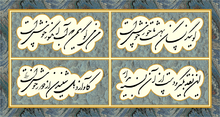
The earliest allusion to Omar Khayyam's poetry is from the historian Imad ad-Din al-Isfahani, a younger contemporary of Khayyam, who explicitly identifies him as both a poet and a scientist (Kharidat al-qasr, 1174).[12]:49[42]:35 One of the earliest specimens of Omar Khayyam's Rubiyat is from Fakhr al-Din Razi. In his work Al-tanbih ‘ala ba‘d asrar al-maw‘dat fi’l-Qur’an (ca. 1160), he quotes one of his poems (corresponding to quatrain LXII of FitzGerald's first edition). Daya in his writings (Mirsad al-‘Ibad, ca. 1230) quotes two quatrains, one of which is the same as the one already reported by Razi. An additional quatrain is quoted by the historian Juvayni (Tarikh-i Jahangushay, ca. 1226-1283).[42]:36–37[12]:92 In 1340 Jajarmi includes thirteen quatrains of Khayyam in his work containing an anthology of the works of famous Persian poets (Munis al-ahrār), two of which have hitherto been known from the older sources.[43] A comparatively late manuscript is the Bodleian MS. Ouseley 140, written in Shiraz in 1460, which contains 158 quatrains on 47 folia. The manuscript belonged to William Ouseley (1767-1842) and was purchased by the Bodleian Library in 1844.
There are occasional quotes of verses attributed to Omar in texts attributed to authors of the 13th and 14th centuries, but these are also of doubtful authenticity, so that skeptic scholars point out that the entire tradition may be pseudepigraphic.[42]:11 Hans Heinrich Schaeder in 1934 commented that the name of Omar Khayyam "is to be struck out from the history of Persian literature" due to the lack of any material that could confidently be attributed to him. De Blois (2004) presents a bibliography of the manuscript tradition, concluding pessimistically that the situation has not changed significantly since Schaeder's time.[44] Five of the quatrains later attributed to Omar are found as early as 30 years after his death, quoted in Sindbad-Nameh. While this establishes that these specific verses were in circulation in Omar's time or shortly later, it doesn't imply that the verses must be his. De Blois concludes that at the least the process of attributing poetry to Omar Khayyam appears to have begun already in the 13th century.[45] Edward Granville Browne (1906) notes the difficulty to disentangle the authentic from the spurious quatrains: "while it is certain that Khayyam wrote many quatrains, it is hardly possible, save in a few exceptional cases, to assert positively that he wrote any of those ascribed to him".[8]:663
In addition to the Persian quatrains, there are twenty-five Arabic poems attributed to Khayyam which are attested by historians such as al-Isfahani, Shahrazuri (Nuzhat al-Arwah, ca. 1201-1211), Qifti (Tārikh al-hukamā, 1255), and Hamdallah Mustawfi (Tarikh-i guzida, 1339).[12]:39
Richard N. Frye (1975) emphasizes that there are a number of other Persian scholars who occasionally wrote quatrains, including Avicenna, Ghazzali, and Tusi. He concludes that it is also possible that poetry with Khayyam was the amusement of his leisure hours: "these brief poems seem often to have been the work of scholars and scientists who composed them, perhaps, in moments of relaxation to edify or amuse the inner circle of their disciples".[8]:662
The poetry attributed to Omar Khayyam has contributed greatly to his popular fame in the modern period as a direct result of the extreme popularity of the translation of such verses into English by Edward FitzGerald (1859). FitzGerald's Rubaiyat of Omar Khayyam contains loose translations of quatrains from The Bodleian manuscript. It enjoyed such success in the fin de siècle period that a bibliography compiled in 1929 listed more than 300 separate editions,[46] and many more have been published since.[47]
Philosophy
Khayyam considered himself intellectually to be a student of Avicenna.[48] According to Al-Bayhaqi, he was reading the metaphysics in Avicenna's the Book of Healing before he died.[8]:661 There are six philosophical papers believed to have been written by Khayyam. One of them, On existence (Fi’l-wujūd), is written in Persian and deals with the subject of existence and its relationship to universals. Another paper, titled The necessity of contradiction in the world, determinism and subsistence (Darurat al-tadād fi’l-‘ālam wa’l-jabr wa’l-baqā’), is written in Arabic and deals with free will and determinism.[48]:475 The titles of his other works are On being and necessity (Risālah fī’l-kawn wa’l-taklīf), The Treatise on Transcendence in Existence (Al-Risālah al-ulā fi’l-wujūd), On the knowledge of the universal principles of existence (Risālah dar ‘ilm kulliyāt-i wujūd), and Abridgement concerning natural phenomena (Mukhtasar fi’l-Tabi‘iyyāt).
Religious views
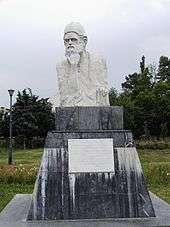
A literal reading of Khayyam's quatrains leads to the interpretation of his philosophic attitude toward life as a combination of pessimism, nihilism, Epicureanism, fatalism, and agnosticism.[12]:6[49] This view is taken by Iranologists such as Arthur Christensen, H. Schaeder, Richard N. Frye, E. D. Ross,[50]:365 E.H. Whinfield[33]:40 and George Sarton.[9]:18 Conversely, the Khayyamic quatrains have also been described as mystical Sufi poetry. However, this is the view of a minority of scholars.[51] In addition to his Persian quatrains, J. C. E. Bowen (1973) mentions that Khayyam's Arabic poems also "express a pessimistic viewpoint which is entirely consonant with the outlook of the deeply thoughtful rationalist philosopher that Khayyam is known historically to have been."[52]:69 Edward FitzGerald emphasized the religious skepticism he found in Khayyam.[53] In his preface to the Rubáiyát he claimed that he "was hated and dreaded by the Sufis",[54] and denied any pretense at divine allegory: "his Wine is the veritable Juice of the Grape: his Tavern, where it was to be had: his Saki, the Flesh and Blood that poured it out for him."[55]:62 Sadegh Hedayat is one of the most notable proponents of Khayyam's philosophy as agnostic skepticism, and according to Jan Rypka (1934), he even considered Khayyam an atheist.[56] Hedayat (1923) states that "while Khayyam believes in the transmutation and transformation of the human body, he does not believe in a separate soul; if we are lucky, our bodily particles would be used in the making of a jug of wine."[57] In a later study (1934–35) he further contends that Khayyam's usage of Sufic terminology such as "wine" is literal and that he turned to the pleasures of the moment as an antidote to his existential sorrow: "Khayyam took refuge in wine to ward off bitterness and to blunt the cutting edge of his thoughts."[58] In this tradition, Omar Khayyam's poetry has been cited in the context of New Atheism, e.g. in The Portable Atheist by Christopher Hitchens.[59]
Al-Qifti (ca. 1172–1248) appears to confirm this view of Omar's philosophy.[8]:663 In his work The History of Learned Men he reports that Omar's poems were only outwardly in the Sufi style, but were written with an anti-religious agenda.[50]:365 He also mentions that he was at one point indicted for impiety, but went on a pilgrimage to prove he was pious.[12]:29 The report has it that upon returning to his native city he concealed his deepest convictions and practised a strictly religious life, going morning and evening to the place of worship.[50]:355
In the context of a piece entitled On the Knowledge Of the Principals of Existence, Khayyam endorses the Sufi path.[12]:8 Csillik (1960) suggests the possibility that Omar Khayyam could see in Sufism an ally against orthodox religiosity.[60]:75 Other commentators do not accept that Omar's poetry has an anti-religious agenda and interpret his references to wine and drunkenness in the conventional metaphorical sense common in Sufism. The French translator J. B. Nicolas held that Omar's constant exhortations to drink wine should not be taken literally, but should be seen in Sufi terms as representing an enlightened state.[61] The view of Omar Khayyam as a Sufi was defended by Bjerregaard (1915),[62] Idries Shah (1999),[63] and Dougan (1991) who attributes the reputation of hedonism to the failings of FitzGerald's translation, arguing that Omar's poetry is to be understood as "deeply esoteric".[64] On the other hand, Iranian experts such as Mohammad Ali Foroughi and Mojtaba Minovi unanimously rejected the hypothesis that Omar Khayyam was a Sufi.[52]:72 Foroughi stated that Khayyam's ideas may have been consistent with that of Sufis at times but there is no evidence that he was formally a Sufi. Aminrazavi (2007) states that "Sufi interpretation of Khayyam is possible only by reading into his Rubāʿīyyāt extensively and by stretching the content to fit the classical Sufi doctrine."[12]:128 Furthermore, Frye (1975) emphasizes that Khayyam was intensely disliked by a number of celebrated Sufi mystics who belonged to the same century. This includes Shams Tabrizi (spiritual guide of Rumi),[12]:58 Najm al-Din Daya who described Omar Khayyam as "an unhappy philosopher, atheist, and materialist",[52]:71 and Attar who regarded him not as a fellow-mystic but a free-thinking scientist who awaited punishments hereafter.[8]:663
Seyyed Hossein Nasr argues that it is "reductive" to use a literal interpretation of his verses (many of which are of uncertain authenticity to begin with) to establish Omar Khayyam's philosophy. Instead, he adduces Khayyam's interpretive translation of Avicenna's treatise Discourse on Unity (Al-Khutbat al-Tawhīd), where he expresses orthodox views on Divine Unity in agreement with the author.[65] The prose works believed to be Omar's are written in the Peripatetic style and are explicitly theistic, dealing with subjects such as the existence of God and theodicy.[12]:160 As noted by Bowen these works indicate his involvement in the problems of metaphysics rather than in the subtleties of Sufism.[52]:71 As evidence of Khayyam's faith and/or conformity to Islamic customs, Aminrazavi mentions that in his treatises he offers salutations and prayers, praising God and Muhammad. In most biographical extracts, he is referred to with religious honorifics such as Imām, The Patron of Faith (Ghīyāth al-Dīn), and The Evidence of Truth (Hujjat al-Haqq).[12] He also notes that biographers who praise his religiosity generally avoid making reference to his poetry, while the ones who mention them often do not praise his religious character.[12]:48 For instance Al-Bayhaqi's account which antedates by some years other biographical notices, speaks of Omar as a very pious man who professed orthodox views down to his last hour.[66]:174
On the basis of all the existing textual and biographical evidence, the question remains somewhat open,[12]:11 and as a result Khayyam has received sharply conflicting appreciations and criticisms.[50]:350
Reception
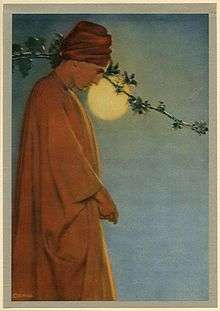
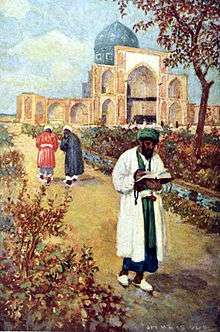
The various biographical extracts referring to Omar Khayyam describe him as unequalled in scientific knowledge and achievement during his time.[67] Many called him with the epithet King of the Wise (Arabic: ملک الحکما).[43]:436[28]:141 Shahrazuri (d. 1300) esteems him highly as a mathematician, and claims that he may be regarded as "the successor of Avicenna in the various branches of philosophic learning."[50]:352 Al-Qifti (d. 1248) even though disagreeing with his views concedes he was "unrivalled in his knowledge of natural philosophy and astronomy."[50]:355 Despite being hailed as a poet by a number of biographers, according to Richard Nelson Frye "it is still possible to argue that Khayyam's status as a poet of the first rank is a comparatively late development."[8]:663
Thomas Hyde was the first European to call attention to Omar and to translate one of his quatrains into Latin (Historia religionis veterum Persarum eorumque magorum, 1700).[68]:525 Western interest in Persia grew with the Orientalism movement in the 19th century. Joseph von Hammer-Purgstall (1774-1856) translated some of Khayyam's poems into German in 1818, and Gore Ouseley (1770-1844) into English in 1846, but Khayyam remained relatively unknown in the West until after the publication of Edward FitzGerald's Rubaiyat of Omar Khayyam in 1859. FitzGerald's work at first was unsuccessful but was popularised by Whitley Stokes from 1861 onward, and the work came to be greatly admired by the Pre-Raphaelites. In 1872 FitzGerald had a third edition printed which increased interest in the work in America. By the 1880s, the book was extremely well known throughout the English-speaking world, to the extent of the formation of numerous "Omar Khayyam Clubs" and a "fin de siècle cult of the Rubaiyat"[69] Khayyam's poems have been translated into many languages, many of the more recent ones are more literal than that of FitzGerald.[70]
FitzGerald's translation was a factor in rekindling interest in Khayyam as a poet even in his native Iran.[71] Sadegh Hedayat in his Songs of Khayyam (Taranehha-ye Khayyam, 1934) reintroduced Omar's poetic legacy to modern Iran. Under the Pahlavi dynasty, a new monument of white marble, designed by the architect Houshang Seyhoun, was erected over his tomb. A statue by Abolhassan Sadighi was erected in Laleh Park, Tehran in the 1960s, and a bust by the same sculptor was placed near Khayyam's mausoleum in Nishapur. In 2009, the state of Iran donated a pavilion to the United Nations Office in Vienna, inaugurated at Vienna International Center.[72] In 2016, three statues of Khayyam were unveiled: one at the University of Oklahoma, one in Nishapur and one in Florence, Italy.[73] Over 150 composers have used the Rubaiyat as their source of inspiration. The earliest such composer was Liza Lehmann.[4]
FitzGerald rendered Omar's name as "Tentmaker", and the anglicized name of "Omar the Tentmaker" resonated in English-speaking popular culture for a while. Thus, Nathan Haskell Dole published a novel called Omar, the Tentmaker: A Romance of Old Persia in 1898. Omar the Tentmaker of Naishapur is a historical novel by John Smith Clarke, published in 1910. "Omar the Tentmaker" is also the title of a 1914 play by Richard Walton Tully in an oriental setting, adapted as a silent film in 1922. US General Omar Bradley was given the nickname "Omar the Tent-Maker" in World War II.[74] The name has also been recorded as a slang expression for "penis".[75]
The lunar crater Omar Khayyam was named in his honour in 1970, as was the minor planet 3095 Omarkhayyam discovered by Soviet astronomer Lyudmila Zhuravlyova in 1980.[76]
.jpg)
See also
Citations
- 1 2 3 "Omar Khayyam (Persian poet and astronomer)". Britannica.com. Retrieved 2012-05-30.
- 1 2 Seyyed Hossein Nasr and Mehdi Aminrazavi. An Anthology of Philosophy in Persia, Vol. 1: From Zoroaster to 'Umar Khayyam, I.B. Tauris in association with The Institute of Ismaili Studies, 2007.
- ↑ "Omar Khayyam | Persian poet and astronomer". Encyclopedia Britannica. Retrieved 2018-07-13.
Omar Khayyam, Arabic in full Ghiyāth al-Dīn Abū al-Fatḥ ʿUmar ibn Ibrāhīm al-Nīsābūrī al-Khayyāmī, (born May 18, 1048, Neyshābūr [also spelled Nīshāpūr], Khorāsān [now Iran]—died December 4, 1131, Neyshābūr), Persian mathematician, astronomer, and poet
- 1 2 3 4 5 6 7 8 9 10 Multiple Authors. "KHAYYAM, OMAR". Encyclopædia Iranica Online. Retrieved 5 October 2017.
- ↑ O'Connor, John J.; Robertson, Edmund F., "Omar Khayyam", MacTutor History of Mathematics archive, University of St Andrews .
- 1 2 3 4 5 6 7 8 9 10 Struik, D. (1958). Omar Khayyam, mathematician. The Mathematics Teacher, 51(4), 280-285.
- ↑ With an error of one day accumulating over 5,000 years, it was more precise than the Gregorian calendar of 1582, which has an error of one day in 3,330 years in the Gregorian calendar (Aminrazavi 2007:200).
- 1 2 3 4 5 6 7 8 9 10 11 The Cambridge History of Iran, Volume 4. Cambridge University Press (1975): Richard Nelson Frye
- 1 2 The Tomb of Omar Khayyâm, George Sarton, Isis, Vol. 29, No. 1 (Jul., 1938), 15.
- ↑ Edward FitzGerald, Rubaiyat of Omar Khayyam, Ed. Christopher Decker, (University of Virginia Press, 1997), xv;"The Saljuq Turks had invaded the province of Khorasan in the 1030s, and the city of Nishapur surrendered to them voluntarily in 1038. Thus Omar Khayyam grew to maturity during the first of the several alien dynasties that would rule Iran until the twentieth century.".
- ↑ Peter Avery and John Heath-Stubbs, The Ruba'iyat of Omar Khayyam, (Penguin Group, 1981), 14;"These dates, 1048-1031, tell us that Khayyam lived when the Saljuq Turkish Sultans were extending and consolidating their power over Persia and when the effects of this power were particularly felt in Nishapur, Khayyam's birthplace.
- 1 2 3 4 5 6 7 8 9 10 11 12 13 14 15 16 17 18 19 20 21 Mehdi Aminrazavi, The Wine of Wisdom: The Life, Poetry and Philosophy of Omar Khayyam, Oneworld Publications (2007)
- ↑ in e.g. Al-Qifti (Aminrazavi 2007:55) or Abu'l-Hasan Bayhaqi. (E. D. R., & H. A. R. G. (1929:436).
- ↑ Frye (1975:658); e.g. in Rashid-al-Din Hamadani (Browne 1899:409f) or in Munis al-ahrār (Ross 1927:436).
- ↑ E. D. R., & H. A. R. G. (1929). The Earliest Account of 'Umar Khayyām. Bulletin of the School of Oriental Studies, University of London, 5(3), 467-473.
- 1 2 3 Great Muslim Mathematicians. Penerbit UTM (July 2000): Mohaini Mohamed
- ↑ (Rozenfeld 1988, pp. 64–65)
- ↑ (Katz 1998, p. 270). Excerpt: In some sense, his treatment was better than ibn al-Haytham's because he explicitly formulated a new postulate to replace Euclid's rather than have the latter hidden in a new definition.
- ↑ Rolwing, R., & Levine, M. (1969). THE PARALLEL POSTULATE. The Mathematics Teacher, 62(8), 665-669.
- ↑ Smith, David, 1935, "Euclid, Omar Khayyam and Saccheri," Scripta Mathematica.
- 1 2 Cooper, G. (2003). Journal of the American Oriental Society,123(1), 248-249.
- ↑ "Khayyam biography". www-history.mcs.st-and.ac.uk. Retrieved 2018-07-13.
However, Khayyam himself seems to have been the first to conceive a general theory of cubic equations.
- ↑ Howard Eves, Omar Khayyam's Solution of Cubic Equations, The Mathematics Teacher (1958), pages 302-303.
- ↑ "Omar Al Hay of Chorassan, about 1079 AD did most to elevate to a method the solution of the algebraic equations by intersecting conics." Guilbeau, Lucye (1930), "The History of the Solution of the Cubic Equation", Mathematics News Letter, 5 (4): 8&ndash, 12, doi:10.2307/3027812, JSTOR 3027812
- ↑ Bijan Vahabzadeh, "KHAYYAM, OMAR xv. As Mathematician", Encyclopædia Iranica.
- ↑ Netz, R. (1999). Archimedes Transformed: The Case of a Result Stating a Maximum for a Cubic Equation. Archive for History of Exact Sciences, 54(1), 1-47.
- 1 2 3 Deborah A. Kent, & David J. Muraki. (2016). A Geometric Solution of a Cubic by Omar Khayyam … in Which Colored Diagrams Are Used Instead of Letters for the Greater Ease of Learners. The American Mathematical Monthly, 123(2), 149-160.
- 1 2 3 4 5 Kennedy, E. (1958). Omar Khayyam. The Mathematics Teacher, Vol. 59, No. 2 (1966), pp. 140-142.
- ↑ A. R. Amir-Moez, "A Paper of Omar Khayyám", Scripta Mathematica 26 (1963), pp. 323–37
- ↑ The Mathematics Teacher, 25(4), 238-241. (1932).
- ↑ A. R. Amir-Moez, Khayyam's Solution of Cubic Equations, Mathematics Magazine, Vol. 35, No. 5 (November 1962), pp. 269–271. This paper contains an extension by the late Mohsen Hashtroodi of Khayyam's method to degree four equations.
- ↑ Mathematical Masterpieces: Further Chronicles by the Explorers, p. 92
- 1 2 3 E. H. Whinfield, The Quatrains of Omar Khayyam, Psychology Press (2000)
- ↑ "Muslim extraction of roots". Mactutor History of Mathematics.
- ↑ J. L. Coolidge, The Story of the Binomial Theorem, Amer. Math. Monthly, Vol. 56, No. 3 (Mar., 1949), pp. 147–157
- ↑ Akrami, Musa (2011). "The development of Iranian calendar: historical and astronomical foundations". arXiv:1111.4926 [physics.hist-ph].
- ↑ Panaino, A; Abdollahy, R; Balland, D. "CALENDARS (In the Islamic period)". Encyclopædia Iranica. Retrieved 21 November 2017.
- ↑ Farrell, Charlotte (1996), "The ninth-century renaissance in astronomy", The Physics Teacher, 34 (5): 268–272, Bibcode:1996PhTea..34..268F, doi:10.1119/1.2344432 .
- ↑ Heydari-Malayeri, M (2004). "concise review of the Iranian calendar". arXiv:astro-ph/0409620.
- ↑ Saliba, G. (2002). Iranian Studies, 35(1/3), 220-225.
- ↑ Donald and Marilynn Olson (1988), 'Zodiac Light, False Dawn, and Omar Khayyam', The Observatory, vol. 108, p. 181-182. "Rex Pay, 2000". Humanistictexts.org. Archived from the original on 2012-03-24. Retrieved 2012-09-08.
- 1 2 3 Ali Dashti (translated by L. P. Elwell-Sutton), In Search of Omar Khayyam, Routledge Library Editions: Iran (2012)
- 1 2 Edward Denison Ross, Omar Khayyam, Bulletin of the School Of Oriental Studies London Institution (1927)
- ↑ Francois De Blois , Persian Literature - A Bio-Bibliographical Survey: Poetry of the Pre-Mongol Period (2004), p. 307.
- ↑ Francois De Blois , Persian Literature - A Bio-Bibliographical Survey: Poetry of the Pre-Mongol Period (2004), p. 305.
- ↑ Ambrose George Potter, A Bibliography of the Rubaiyat of Omar Khayyam (1929).
- ↑ Francois De Blois , Persian Literature - A Bio-Bibliographical Survey: Poetry of the Pre-Mongol Period (2004), p. 312.
- 1 2 Nasr, S. H., & Aminrazavi, M. (2007). Anthology of philosophy in Persia: from Zoroaster to Omar Khayyam.
- ↑ Boscaglia, F. (2015). Pessoa, Borges and Khayyam. Variaciones Borges
- 1 2 3 4 5 6 Ross, E. (1898). Al-Musaffariyé: Containing a Recent Contribution to the Study of 'Omar Khayyām. Journal of the Royal Asiatic Society of Great Britain and Ireland, 349-366.
- ↑ Aminrazavi, Mehdi. "Umar Khayyam". Stanford Encyclopedia of Philosophy. Retrieved 22 November 2017.
- 1 2 3 4 J. C. E. Bowen. (1973). The Rubāՙiyyāt of Omar Khayyam: A Critical Assessment of Robert Graves' and Omar Ali Shah's Translation. Iran, 11, 63-73.
- ↑ Davis, Dick. "FitzGerald, Edward". Encyclopædia Iranica. Retrieved 15 January 2017.
- ↑ FitzGerald, E. (2010). Rubaiyat of Omar Khayyam (p. 12). Champaign, Ill.: Project Gutenberg
- ↑ Schenker, D. (1981). Fugitive Articulation: An Introduction to "The Rubáiyát of Omar Khayyam". Victorian Poetry, 19(1), 49-64.
- ↑ Hedayat's "Blind Owl" as a Western Novel. Princeton Legacy Library: Michael Beard
- ↑ Katouzian, H. (1991). Sadeq Hedayat: The life and literature of an Iranian writer (p. 138). London: I.B. Tauris
- ↑ Bashiri, Iraj. "Hedayat's Learning".
- ↑ Hitchens, C. (2007). The portable atheist: Essential readings for the nonbeliever (p. 7). Philadelphia, PA: Da Capo.
- ↑ CSILLIK, B. (1960). THE REAL 'OMAR KHAYYĀM. Acta Orientalia Academiae Scientiarum Hungaricae, 10(1), 59-77. Retrieved from https://www.jstor.org/stable/23682646
- ↑ Albano, G. (2008). The Benefits of Reading the "Rubáiyát of Omar Khayyám" as Pastoral. Victorian Poetry, 46(1), 55-67.
- ↑ C. H. A. Bjerregaard, Sufism: Omar Khayyam and E. Fitzgerald, The Sufi Publishing Society (1915), p. 3
- ↑ Idries Shah, The Sufis, Octagon Press (1999), pp. 165-166
- ↑ "Every line of the Rubaiyat has more meaning than almost anything you could read in Sufi literature" Abdullah Dougan Who is the Potter? Gnostic Press 1991 ISBN 0-473-01064-X
- ↑ S. H. Nasr, 2006, Islamic Philosophy from Its Origin to the Present, Chapter 9., pp. 165–183
- ↑ Meyerhof, M. (1948). 'Alī al-Bayhaqī's Tatimmat Siwān al-Hikma: A Biographical Work on Learned Men of the Islam. Osiris, 8, 122-217.
- ↑ e.g. by the author of Firdaws al-tawārikh (Ross 1898:356), author of Tārikh alfī (Ross 1898:358), and al-Isfahani (Aminrazavi 2007:49).
- ↑ Beveridge, H. (1905). XVIII. Omar Khayyam. Journal of the Royal Asiatic Society, 37(3), 521-526.
- ↑ J. D. Yohannan, Persian Poetry in England and America, 1977., p. 202.
- ↑ The Great Umar Khayyam: A Global Reception of the Rubaiyat (AUP – Leiden University Press) by A. A. Seyed-Gohrab, 2012.
- ↑ Simidchieva, M. (2011). FitzGerald's Rubáiyát and Agnosticism. In A. Poole, C. Van Ruymbeke, & W. Martin (Eds.), FitzGerald's Rubáiyát of Omar Khayyám: Popularity and Neglect (pp. 55-72). Anthem Press.
- ↑ UNIS. "Monument to Be Inaugurated at the Vienna International Centre, 'Scholars Pavilion' donated to International Organizations in Vienna by Iran".
- ↑ "Khayyam statue finally set up at University of Oklahoma". Tehran Times. Archived from the original on 2016-04-05. Retrieved 2016-04-04.
- ↑ Jeffrey D. Lavoie, The Private Life of General Omar N. Bradley (2015), p. 13.
- ↑ Michael Kimmel, Christine Milrod, Amanda Kennedy, Cultural Encyclopedia of the Penis (2014), p. 93.
- ↑ Dictionary of Minor Planet Names – p.255. Books.google.com. 1979-02-26. Retrieved 2012-09-08.
References
- Browne, E. (1899). Yet More Light on 'Umar-i-Khayyām. Journal of the Royal Asiatic Society of Great Britain and Ireland, 409-420.
- Turner, Howard R. (1997). Science in Medieval Islam: An Illustrated Introduction. University of Texas Press. ISBN 0-292-78149-0.
- Jos Biegstraaten (2008). "Omar Khayyam (Impact On Literature And Society In The West)". Encyclopaedia Iranica. vol. 15. Encyclopaedia Iranica Foundation.
- Nasr, S. H. (2006). Islamic Philosophy from Its Origin to the Present: Philosophy in the Land of Prophecy. SUNY Press. ISBN 0-7914-6799-6.
- Katz, Victor (1998). A History of Mathematics: An Introduction (2 ed.). Addison-Wesley. p. 879. ISBN 0-321-01618-1.
- KnoebelNasr, Arthur; Laubenbacher, Reinhard; Lodder, Jerry; Pengelley, David (2007). Mathematical Masterpieces: Further Chronicles by the Explorers. Springer. ISBN 0-387-33061-5.
- ed. by J.A. Boyle. (1968). The Cambridge History of Iran (5): The Saljug and Mongol Periods. Cambridge University Press. ISBN 0-521-06936-X.
- Smith, David Eugene (1935). "Euclid, Omar Khayyâm, and Saccheri". Scripta Mathematica. III (1): 5–10. OCLC 14156259.
- Rozenfeld, Boris A. (1988). A History of Non-Euclidean Geometry: Evolution of the Concept of a Geometric Space. Springer Verlag. pp. 65, 471. ISBN 0-387-96458-4.
- Ross, E. (1927). 'Omar Khayyam. Bulletin of the School of Oriental Studies, University of London, 4(3), 433-439.
- Jan Rypka (1968). History of Iranian Literature. Reidel Publishing Company. OCLC 460598. ISBN 90-277-0143-1
External links
| Wikisource has original works written by or about: Omar Khayyám |
| Wikiquote has quotations related to: Omar Khayyam |
| Wikimedia Commons has media related to Omar Khayyam. |
- Hashemipour, Behnaz (2007). "Khayyām: Ghiyāth al‐Dīn Abū al‐Fatḥ ʿUmar ibn Ibrāhīm al‐Khayyāmī al‐Nīshāpūrī". In Thomas Hockey; et al. The Biographical Encyclopedia of Astronomers. New York: Springer. pp. 627–8. ISBN 978-0-387-31022-0. (PDF version)
- Umar Khayyam, at the Stanford Encyclopedia of Philosophy
- Khayyam's works in original Persian at Ganjoor Persian Library
- Khayyam in Tarikhema.ir
- Works by Omar Khayyam at Project Gutenberg
- Works by Omar Khayyám at Faded Page (Canada)
- Works by or about Omar Khayyam at Internet Archive
- Works by Omar Khayyam at LibriVox (public domain audiobooks)

- The illustrated Rubáiyát of Omar Khayyám at Internet Archive.
- Omar Khayyam's Rubaiyat as translated by Edward Fitzgerald – 1st edition
- The Rubaiyat by Omar Khayyam – The Internet Classics Archive
- Illustrations to the Rubaiyat by Adelaide Hanscom
- Barney Rickenbacker, Exploring Khayyaam website. Different versions of well-known quatrains compared, with notes.